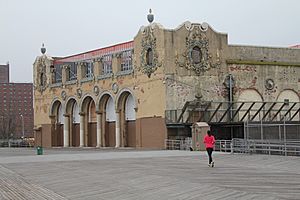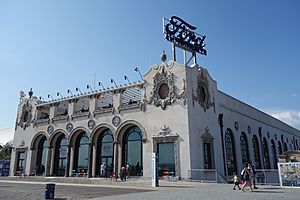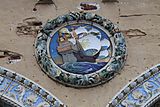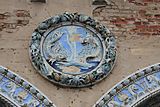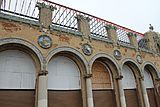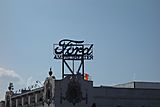Childs Restaurants (Riegelmann Boardwalk location) facts for kids
Quick facts for kids Childs Restaurant |
|
|---|---|
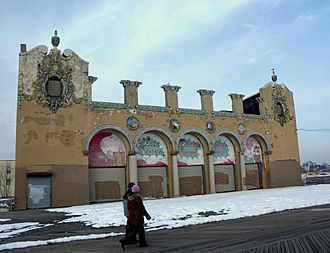
Facade from Coney Island Boardwalk
|
|
| General information | |
| Coordinates | 40°34′21″N 73°59′15″W / 40.5725°N 73.9876°W |
| Current tenants | Ford Amphitheater at Coney Island |
| Opened | 1923 |
| Renovated | 2016 |
The Childs Restaurant building is a famous landmark in Coney Island, Brooklyn, New York City. It's right on the Riegelmann Boardwalk at West 21st Street. This building opened in 1923. It was built for Childs Restaurants, which was one of the biggest restaurant chains in the United States back then.
Its design is called "resort style with Spanish Revival influence." It has colorful decorations made of terra cotta on the outside. These decorations show things from the ocean, like Poseidon (the Greek god of the sea), sailing ships, and sea creatures. It was a huge restaurant with three floors and even a garden on the roof!
Childs Restaurants left the building in 1952. For over 50 years, it was used as a candy factory. The building then sat empty and started to fall apart. But from 2013 to 2015, it was fixed up and turned into the Ford Amphitheater at Coney Island.
There was an even older Childs Restaurant in Coney Island. It was built in 1917 on Surf Avenue. That building is now owned by Coney Island USA, an arts group.
Contents
What Does the Building Look Like?
The Childs Restaurant building is very long. It stretches about 100 feet (30 meters) along the Boardwalk. It also goes about 250 feet (76 meters) along West 21st Street. The building has three stories and a garden on the roof.
It has about 60,000 square feet (5,574 square meters) of space inside. It was built in 1923 to offer affordable meals. Millions of people came to Coney Island to enjoy the beaches and fun rides. They also loved walking along the Boardwalk, which was built the same year. Most visitors arrived by New York City Subway, which had a new station nearby.
Building's History
How the Restaurant Operated
From the very beginning, Childs Restaurants were known for their nice interiors. They had white tile walls and floors. There were also marble tables and modern electric lights. Many Childs locations were in rented spaces. But when the company started building its own restaurants, they wanted them to look just as good.
For the Boardwalk location, they chose the architects Hirons and Dennison. This firm was known for designing banks. They often worked with sculptors and a company called Atlantic Terra Cotta. They used these skills to create the beautiful terra cotta panels on the Boardwalk building. The "Spanish Revival" style was a new look for them.
The Coney Island Boardwalk restaurant became very popular. Its design was even used as a model for other Childs locations. One example is a restaurant built in 1927 on the Atlantic City boardwalk. Even though Childs operated in cities, people started to connect the name with the seashore. This was mostly because of the large Coney Island building. Childs even used a "nautical" (sea-themed) look for new buildings far from the ocean.
Changes Over the Years
Coney Island became less popular in the 1940s and 1950s. People started to find other places to visit. Many businesses in Coney Island closed during this time. Childs closed its Boardwalk location in 1952.
A family named Ricci bought the building. They used it as a candy factory. At one point, marshmallow candies like Peeps were made there! Candy making continued into the early 2000s. By 2008, the building was used as a roller skating rink. But the owners decided to stop that in 2010.
New Life for the Building
The idea to turn the old Childs building into something new came from Marty Markowitz. He was the Borough President of Brooklyn from 2002 to 2013. Markowitz wanted a permanent place for summer concerts. He had been sponsoring these concerts for 35 years.
In December 2013, the New York City Council approved plans to fix up the building. It would become a new entertainment spot called the "Seaside Park and Community Arts Center." The city hoped it would be ready by summer 2015. The new venue, called the Ford Amphitheater at Coney Island, officially opened on July 1, 2016.
A new stage was built on the west side of the building. The amphitheater now has backstage areas and a box office. It also has a restaurant, which is the first one there in over sixty years! There's also a green space next to it called Seaside Park.
Landmark Status
In 2002, the New York City Landmarks Preservation Commission made the building a landmark. This means it is protected and cannot be torn down easily. The family who owned the building at the time first didn't want this. But then they changed their minds.
In Movies
The Childs Restaurant building was used in the 2002 movie Two Weeks Notice. In the romantic comedy, Sandra Bullock plays a lawyer. Her character wants to save a community center from her childhood in Coney Island. The old restaurant building was used as the filming location for this "community center."
Gallery
- Childs Restaurant at Riegelmann Boardwalk
Images for kids
-
Terracotta relief of the restaurant, seen at the Coney Island History Project


